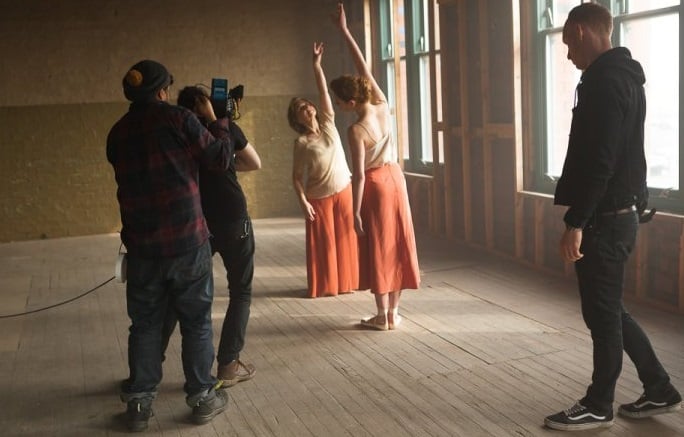
Filming 'Haud Close Tae Me' for Scottish Ballet's Digital Season
Photo: Christina Riley
A digital season
Scottish Ballet’s first digital season gave the company the opportunity to experiment with new technologies, but would audiences like it? Charlotte Gross tells the story.
Digital technology has deeply transformed the way we consume information, plan and organise our lives. Digital marketing and communications have also opened up opportunities for touring arts organisations to engage with audiences in a more meaningful way, keeping a connection all year around rather than just during tours.
We wanted to let our audiences get ‘under the skin’ of Scottish Ballet and to see dance differently
Scottish Ballet does ground-breaking work on stage with influential choreographers and we also seek to engage with communities in the UK and around the world with the use of digital. In 2009 we won the Golden Tweet Award (Business to Consumer); in 2011 our education department initiated the first UK dance live stream from our studios in Glasgow; and in 2016 our resident filmmaker Eve McConnachie’s film Maze won Best Screendance Short Under 10 Minutes at the San Francisco Dance Film Festival.
And in April this year we launched our first Digital Season. Christopher Hampson, our CEO and Artistic Director, set out to create a month-long programme of dance for a digital format, opening the organisation, dancers and choreographers to new ways of working, new technologies and new collaborations.
We wanted to let our audiences get ‘under the skin’ of Scottish Ballet and to see dance differently. We were very fortunate to be supported by the John Ellerman Foundation, which completely embraced the concept and enabled it to happen. We also received support and funding from KPMG, Baillie Gifford and the Garrick Charitable Trust.
It included the premiere of four new dance films, including a 360 degree film and a work created live in five days (daily live streams showing the choreographic process), the stream of a full class, a digital art installation and a pop-up gallery in Tramway.
The season allowed us to work with creatives from other fields such as photographer and director David Eustace, poet Jackie Kay and composer Alex Menzies. We also continued to develop a creative partnership with choreographer James Cousins as well as collaborate with the BBC, Nowness, Google, Pointe Magazine and Glasgow School of Art. It also allowed us to showcase our own creative talents in a different way and provide something special for our audiences while the company was on tour in the US.
Measures of success
Prior to the season starting, we had defined clear key performance indicators (KPIs) to measure its success.
- Video views: We had over 718,000 video views spread across partner channels and our own channels. That was well above our expectations. 91% of these views were made on Facebook, reflecting our distribution choices, but also the increased video market share Facebook has now. Just under half of the views were made on our channels, highlighting the importance of finding good distribution partners.
- Fan acquisition: During the season we gained over 3,000 new followers across YouTube and Facebook, as well as significant new e-newsletter sign-ups (through the website or Facebook), significantly higher numbers than during the previous two spring seasons. These are people that we can now engage with and market to at a much reduced cost.
- Engagement with dancers: The dancers’ pages on the website had 64% more visits than during the Swan Lake tour in spring 2016. The films released and the social media activities that these have enabled have been successful in engaging the public and enticing them to learn more about our dancers and develop a deeper connection with them. Once this connection is established, it will become another motivator to watch the company on stage besides repertoire, music, story.
Audience feedback
Our most important KPI was audience feedback. Would they like it, would they engage with it and will it touch them?
In these troubled times society needs art more than ever to help people reflect, pause and connect. As individuals spend increasing amounts of time in the digital world, arts organisations need to bring art to the spaces between the cute pictures of cats and the political debates and the YouTubers.
As technology and communication tools move at a fast pace, it’s essential that we maintain a culture that enables experimentation within art organisations. The digital world is hungry for content and arts organisations are in a great position to play a significant part in this space.
Charlotte Gross is Head of Sales & Marketing at Scottish Ballet and Producer of its Digital Season.
www.scottishballet.co.uk
Tw @scottishballet
Join the Discussion
You must be logged in to post a comment.